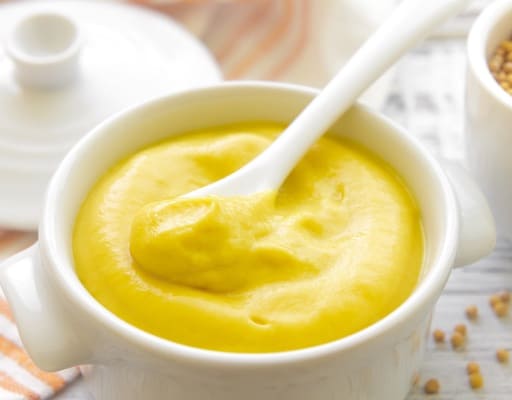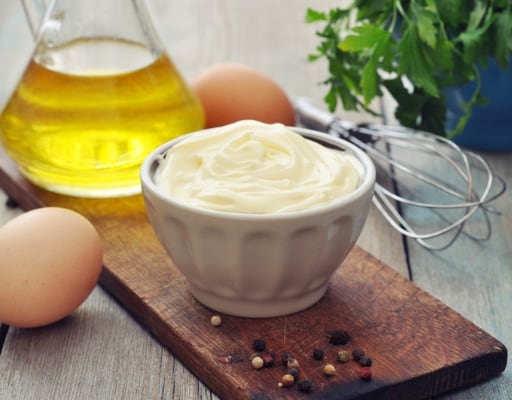It’s possible that you may not share the enthusiasm for mustard as much as many Mayo-freaks do when making mayo, and perhaps rightly so in order to protect your health or cater for your special relish needs.
So if you’ve been searching for a mustard-free alternative that still maintains the taste and texture of traditional mayo, this article would help you with that.

What Does Mustard Do In Mayonnaise?
That extra scoop of mustard does more than just boost the flavor of your mayonnaise. Here are some key things it does.
Flavor enhancement
Mustard can bear many different characteristics in terms of how it tastes, depending on which product you’re using (e.g., English, Bavarian, Dijon or French mustard)
Overall, thoguh, it seems like mustards do provide some bit of tanginess and spiciness to whatever you’re making, including Mayo.
These help to complement the rich and creamy taste of mayonnaise making it taste better overall.
Emulsifier
Yes, I know this may sound strange but mustard does bring in some emulsifying properties to your Mayo (when used), although its emulsifying properties are only resorted to as a secondary option next to the more abundant lecithin in yolks, the main emulsifier in mayonnaise.
Mustard is able to emulsify because it contains mucilage which helps to lower the interfacial tensions of oil and water emulsions and thus cause both to bind together to create a smooth and stable emulsion that doesn’t separate.
Texture improver
Mustard’s mucilage also contributes to a thicker and creamier texture in mayonnaise which improves the mouthfeel and makes it easier to spread on sandwiches or mix into salads and dips.
Preservative
Mustard also contains acids such as vinegar and lemon juice as well as salt, all of which help to extend the shelf life of homemade mayonnaise by inhibiting the growth of harmful bacteria.
Color enhancement
Instead of a light creamy appearance, mustard adds a subtle yellow hue to mayonnaise, giving it a more appealing and appetizing appearance.
Of course not everyone would like their Mayo slightly yellow, and if you fall in that category, then continue reading to find out what to about it.
Can You Leave Out Mustard When Making Mayonnaise?
Yes, you can leave out mustard when making mayonnaise.
Although mustard is a common ingredient in traditional mayonnaise recipes because it adds flavor, acts as an emulsifier, gives color as well as build texture, it is not absolutely necessary, and you can ditch it out of the recipe without making any additions or subtractions to the formula.
What Can You Substitute For Mustard In Mayonnaise?
Mustard serves not only one function in a Mayo but many. Thankfully, it’s emulsifying capabilities are already cratered for by another ingredient in the mix which is egg yolks.
So I’ll assume you’re not substituting mustard for its emulsifying properties but rather flavor, color, texture building capabilities as well as health implications.
For flavor, there are a lot of spices and seasonings to try and truly, you are your own limit. You can use dll, honey, basil, sriracha, capers, ketchup, chives, parsley, black pepper, chipotle etc.

If you want color, simply ditching the egg whites from the recipe should provide you with a rich yellow hue. Using colorful spices too like curry can also make your mayonnaise look colorful.
If allergic reactions are your concerns, simply ditch the bottle of mustard and you’re good to go.
Frequently Asked Questions
Can You Make Mayonnaise Without Mustard And Lemon Juice or Vinegar?
It is possible to make mayonnaise without mustard and lemon juice, or mustard and vinegar.
But it would help to have a little bit of the water content in the form of acids like vinegar and lemon juice because they help in the emulsification process by serving as the aqueous medium.
Without this aqueous medium, or sufficient amount of it, you’d have to rely only on the water content of the yolks, which might not be sufficient.
Additionally, the whole thing of lemon juice and vinegar also helps to stabilize the emulsion that forms, as well as to provide a bit of tartness which makes mayo taste the way it does — delicious. Without these, the flavor of the mayonnaise may suffer.
Already, you know that mustard can be ditched out of the recipe without any problem. But if you want to get rid of vinegar and lemon juice, make sure you’re substituting one for the other and not just eliminating both of them completely.
Alternatively, you can use lime juice instead of both. Substitute equally.
Is There A 2 Ingredient Mayonnaise?
Yes, of course, you can make mayonnaise using two-ingredient which are egg and oil — the two main things in a mayonnaise.
But the resulting Mayo will not have the exact same taste and texture as traditional mayo because of the absence of many flavor building ingredients, albeit, it would still taste decent.

Here’s a simple recipe that highlights how to make a 2 ingredient mayonnaise.
Ingredients:
- 1 cup of oil (such as vegetable oil, sunflower oil, or light olive oil)
- 1 large egg yolk
Instructions:
Start by separating the egg yolk from the egg white.
You can do this by cracking the egg over a bowl and using the eggshell halves to transfer the yolk back and forth, allowing the egg white to drop into the bowl. Set aside the egg white for another use and place the yolk in a separate mixing bowl.
Next, whisk the yolk and then slowly pour in the oil while making sure to whisk the mixture vigorously as you do that. You can use a hand or stand mixer instead.
It’s important to pour the oil a drop at a time first, and then in a thin stream and continue whisking to ensure that the oil and egg yolk combine properly.
Keep whisking until you’ve incorporated all the oil and the mixture reaches a creamy consistency similar to that of traditional mayo.
That’s it!
You can now choose to use your bland Mayo as it is or add seasoning into it to taste and alter texture, if you’d like, but then it would no longer be a two-ingredient mayo.
Transfer the Mayo into a jar or container with a lid and store in the refrigerator for upto 2 weeks.

